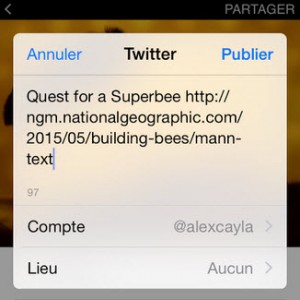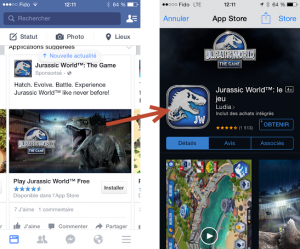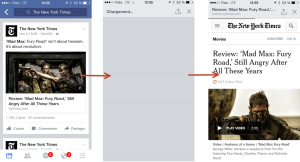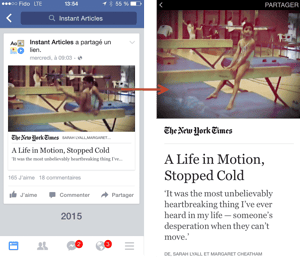Facebook Instant Article: the novelty that is changing the face of the Web
Big news in the media industry this week: Facebook closed a partnership with media giants including the New York Times, BuzzFeed, and National Geographic to host the publishers’ content directly on the social network’s servers. These articles will be presented in a new format, called Instant Articles, and will provide a better reading experience for users.
Rumours had been circulating for a while among American journalists, but until recently, the specific terms and features of the product were unknown. And the offering isn’t as risky as many critics had predicted.
To critics, the new product seemed like a Faustian bargain. Facebook’s newsfeed already gives it significant sway over the media we consume, and having content hosted on the Menlo Park giant’s servers seemed like the logical next step on the path to having Facebook rule as lord and master of the media world. In the end, Facebook made a few concessions to allay those fears:
- Publishers keep 100% of the ad revenue they generate for their articles (and 70% of revenue for ads sold by Facebook)
- They can measure the performance of their articles with the tool of their choice (like Google Analytics or Adobe Analytics)
- Articles can be published using the publisher’s own fonts and style sheets
Additional benefits for partners include:
- Articles that load instantly
- A more immersive experience
- The opportunity to better monetize their Facebook audience
- No additional cost to host these articles
With its 1.25 billion monthly users, Facebook is far and away the most widely used social network. The company already plays a central role in sharing and spreading the news, and already monopolizes a large percentage of time spent on mobile. Since clearly, the company doesn’t “need” to offer such generous terms to it’s large media partners, it makes sense to wonder about their intentions in entering into this partnership.
Facebook’s objectives
There are a number of different hypotheses we could posit about Facebook’s motivations.
Increased profiling capabilities
Since Facebook already has an enormous amount of information about the reading preferences, navigation habits, and preferred applications of a wide range of its users, increasing targeting capabilities is probably not Mark Zuckerberg’s top priority.
Increased lock-in of users and partners
It’s easy to believe that one of the goals of this initiative might be to provide a unique experience that builds customer loyalty and limits the reuse of content (a bit like the interactive iBooks format). However, this isn’t the case.
For one, when a user shares the article on a social network, the link automatically points to the mobile version of the article. So, even though the content is richer within Facebook, it’s still possible to see it directly on the web.
For another, the framework on which Facebook created this new product is available through GitHub. So, though the objective may well be to offer a better experience, the Menlo Park company isn’t trying to keep the recipe a secret. Facebook is proud of its new rollout, and wants to monetize its offering differently.
Create a more engaging experience
The simplest solution is usually the best one: the success of app install ads have demonstrated the power of an integrated experience. The app install format is simple: when a user clicks on an app ad, instead of being sent to the Apple App Store, a screen appears over the newsfeed. The user can download the app directly from there, and once they’re done the screen disappears, allowing them to continue browsing the newsfeed where they left off.
With Instant Articles, Facebook aims to offer the same type of experience for one of the platform’s most common use cases: reading the news.
In addition, Facebook has never hidden the fact that it wants to improve the quality of the content on its site. Much like Google, it’s constantly updating its algorithm to combat clickbait articles. By hosting content on its own servers, Facebook has access to much more detailed information on the quality of its content.
In short, by offering a superior experience, Facebook is counting on keeping users on the site for longer, and monetizing them in that way.
The beginning of the end of the Internet?
At a glance, it might seem like this announcement is only relevant to a handful of companies. However, it’s an indicator of major changes to come for the web.
First off, it confirms the importance of a quality experience. It’s a well-known fact that download speeds have an impact on visitor satisfaction, and Instant Articles further confirms this; the speed with which they display is impressive.
The problem is, it seems like only a native experience (meaning it’s controlled by a platform like Facebook) can offer a content experience of this caliber. For example, Flipboard needed to go beyond the fundamental technology of the web (like the DOM) to be able to offer a web experience as rich as its mobile apps. These two cases tend to indicate that we might have hit the limits of the web as we know it (HTML, CSS, JavaScript, in a browser).
It’s still too soon to say whether Instant Articles signify the beginning of the end for the Internet. Still, they are proof of a major change in the dynamic that’s prevailed up until now between social networks and the media: instead of producing content and pushing it out on different platforms, content now needs to be produced FOR each platform. The Internet (a site viewed by a browser) will soon be merely one channel among many.
Admittedly, Instant Articles are still not available to everyone (and there’s still no format for brands). However, they’re part of a clear trend – the growing importance of native content for social networks (like Snapchat Discover and Twitter Cards).
It’s only a matter of time. Which means that it’s in the best interest of organizations to start preparing for the change now, by putting in place a holistic content strategy, and creating robust content management processes.












